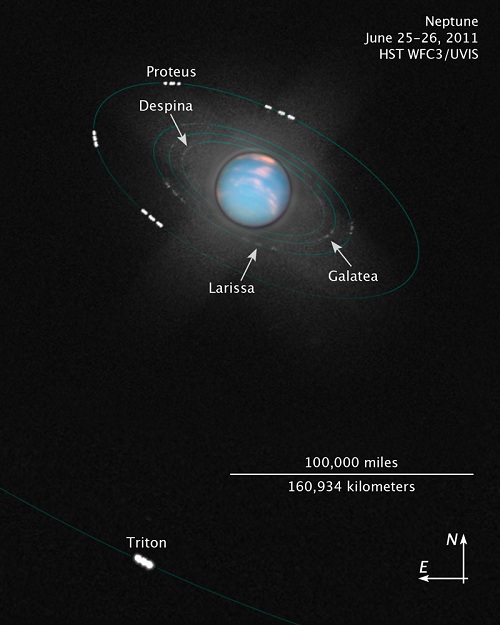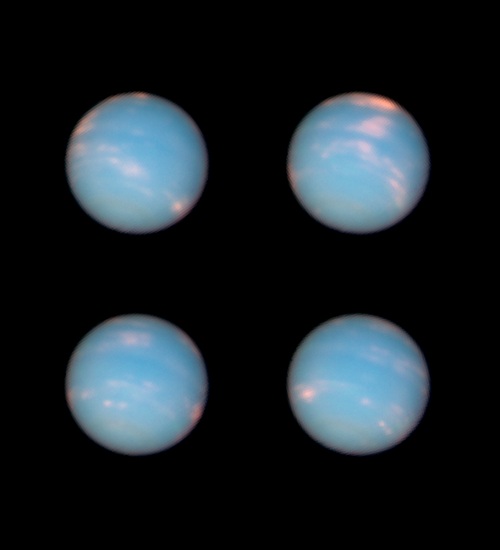When the German astronomer Johann Gottfried Galle discovered Neptune on September 23, 1846, he found a world so distant from the Sun that its orbit takes 165 years to complete. With Neptune reaching its first complete revolution since discovery, an event that occurred yesterday, we can enjoy some celebratory Hubble imagery of the planet. I especially like the shot below, which not only shows atmospheric features but also has been tweaked to reveal some of Neptune’s moons. The planet has about thirty moons, most of them too faint to appear in these images.

Image: This illustration was composed from numerous separate Hubble Wide Field Camera 3 images. A color image composed of exposures made through three color filters shows the disk of Neptune, revealing clouds in its atmosphere. Forty-eight individual images from a single filter were brightened to reveal the very faint moons and composited with the color image. The white dots are Neptune’s inner moons moving along their orbits during Hubble’s observations. The solid green lines trace the full orbit of each moon. The spacing of the moon images follows the timing of each Hubble exposure. Triton, in the lower left corner, is the brightest of the moons seen in these images, farthest from the planet, and moves in a counter-clockwise sense in this view. Next closest to Neptune is Proteus, followed by Larissa, Galatea and Despina, all of which move clockwise in this view, opposite to Triton’s (retrograde) motion. Credit: NASA, ESA, and the Hubble Heritage Team (STScI/AURA).
The four images below were taken with Hubble’s Wide Field Camera 3 in late June, spaced at four hour intervals to offer a full view of the planet’s 16-hour rotation. You can make out high-altitude clouds of methane ice crystals in the northern and southern hemispheres. And just as we’ve recently looked at seasonal changes on Saturn, the Hubble imagery reveals similar changes on Neptune, with cloud activity shifting to the northern hemisphere. The southern hemisphere is now in early summer, while the northern hemisphere has entered winter. Neptune has an axial tilt of 29 degrees, creating seasons that last for some forty years each.

Image: In the Hubble images, absorption of red light by methane in Neptune’s atmosphere gives the planet its distinctive aqua color. The clouds are tinted pink because they are reflecting near-infrared light. A faint, dark band near the bottom of the southern hemisphere is probably caused by a decrease in the hazes in the atmosphere that scatter blue light. The band was imaged by NASA’s Voyager 2 spacecraft in 1989, and may be tied to circumpolar circulation created by high-velocity winds in that region. The temperature difference between Neptune’s strong internal heat source and its frigid cloud tops, about minus 260 degrees Fahrenheit, might trigger instabilities in the atmosphere that drive large-scale weather changes. Credit: NASA, ESA, and the Hubble Heritage Team (STScI/AURA).
The story of Neptune’s discovery is a fascinating topic in itself. Galileo actually recorded Neptune in his notebooks but didn’t follow up the observation. British astronomer William Herschel would later note that the orbit of Uranus did not behave as expected according to Newton’s laws, leading to speculations (like those of French astronomer Alexis Bouvard in 1821) that another planet was tugging at Uranus. Both Urbain Le Verrier and John Couch Adams predicted the location of the putative planet in the 1840s, but it was Le Verrier who described his prediction to Galle at the Berlin Observatory. After that, it was a matter of two nights of observation before Galle was able to identify the planet. Although the Royal Society would award Le Verrier the Copley Medal for his work, supporters of Adams defended his right to be considered a co-discoverer. Recent work has cast doubt on the idea.
Neptune makes numerous appearances in science fiction, such as Samuel Delany’s Triton (1976) and Jeffrey Carver’s Neptune Crossing (1994), in both of which much of the action takes place on Neptune’s largest moon. But earlier appearances are interesting, including Olaf Stapledon’s Last and First Men (1930), in which the planet serves as humanity’s final home. H.G. Wells likewise wrote about Neptune in ‘The Star’ (1897), a short story in which the planet is destroyed by a collision with what appears to be a rogue wandering planet from the interstellar deep. The event puts a brilliant new star in Earth’s sky, one that inexorably approaches our planet. Interestingly, the massive new object now gets a gravitational assist from Jupiter, as foreseen by a canny mathematician who forecasts the end of the human race:
The new planet and Neptune, locked in a fiery embrace, were whirling headlong, ever faster and faster towards the sun. Already every second this blazing mass flew a hundred miles, and every second its terrific velocity increased. As it flew now, indeed, it must pass a hundred million of miles wide of the earth and scarcely affect it. But near its destined path, as yet only slightly perturbed, spun the mighty planet Jupiter and his moons sweeping splendid round the sun. Every moment now the attraction between the fiery star and the greatest of the planets grew stronger. And the result of that attraction? Inevitably Jupiter would be deflected from its orbit into an elliptical path, and the burning star, swung by his attraction wide of its sunward rush, would “describe a curved path” and perhaps collide with, and certainly pass very close to, our earth. “Earthquakes, volcanic outbreaks, cyclones, sea waves, floods, and a steady rise in temperature to I know not what limit”–so prophesied the master mathematician.
‘The Star’ is still a good read (Wells’ Martians even make an appearance). You can read it online here, an enjoyable way to celebrate Neptune’s first full year since discovery.




The current tally of known Neptunian satellites stands at 13. There are probably lots more small irregular satellites waiting to be found though.
I was drawing that figure of 30 from this:
http://hubblesite.org/newscenter/archive/releases/2011/19/image/g/
where the caption uses the number of moons ‘known to orbit Neptune,’ but maybe they’re being overly speculative.
Amazing picture of Neptune! So, so far away. I remember reading a sci-fi novel called “The Killing Star” in which humanity had bases way out there as well as a giant telescope sometime late in the 21st century. Hope such a vision becomes reality for future generations.
And Paul, one Neptunian year equals 164.79 Earth years, not 165 years.
I just don’t know…. :^)
Larry, I never could get the length of Neptune’s year right… ;-)
Triton, which orbits Neptune retrograde (in the direction opposite that in which Neptune orbits the Sun) is thought to have once been a planet in right orbiting the Sun independently, a Kuiper Belt planet compositionally similar to Pluto. At some point, it was captured by Neptune; the capture is reflected in its orbit, which is not only retrograde but unstable. Eventually, in several hundred million years (not sure of the estimated time), Triton will crash into Neptune.
Laurel Kornfeld, Triton also interests me. There must have been a massive release of heat over several million years when its orbit first circularised, and the continual impact with smaller native moons might have kept up a supply of subsurface lakes to this day. I can’t help but feel, that despite its distance, it has to be one of Sol’s best candidates as a living world.
PS, though I do not know the correct astronomical definition of retrograde, by your definition all sizable moons of Uranus are such. A more sensible basis would be planetary axial rotation.
I remember when Voyager 2 flew by Neptune in 1989 and began beaming back those amazing images of Triton, someone at JPL commented that they may be getting a look at Pluto after all. Voyager 1 could have flown by Pluto in 1988, but it was sent to look at Titan up close in 1980 and visited no more worlds in this Sol system after that.
Hopefully in our life times we can see Triton up close again. I am curious to know if its surface features have changed at all since 1989.
I read in a book that when Triton eventually falls into Neptune, that it will break up and create prominent rings.
I’m definitely in the LeVerrier camp as far as the discovery. The Frenchmans calculations were much more accurate. If you took relativity into account, they might’ve been almost exact. Discovering a planet through calculations is impressive, and could be a precedent for the exoplanet search.
I’ve always been interested in the possibilities of outposts/industry/colonies around the gas giants. However, the ice giants are extremely cold and distant, and that could be a significant obstacle. There may be more to these planets than we’re aware of so far.
It is actually quite impressive that the calculations worked at all given that it was assumed that the planet’s orbital distance would fit the Titius-Bode law. The actual orbit does not. See Greg Laughlin’s blog post from back in January about this.
Saturday, July 16, 2011
Neptune’s Birthday
Just after midnight on September 24th of this year, Neptune will be exactly 165 earth years older. It was on that date, back in 1846, that German Astronomer Johann Galle, assisted by graduate student Heinrich Louis d’Arrest, trained the 24 centimeter (9 inch) Fraunhofer Refractor of the Berlin Observatory on a patch of sky near the Aquarius-Capricorn border (see illustration below) and observed the small, blue disk of Neptune.
On July 12th of this year, Neptune completed exactly one orbit since its discovery. One hundred and sixty five years ago a series of events played out in France, England and Germany that would culminate in a watershed moment in the history science and astronomy, a discovery that would prove to be unique and unrepeatable. These events were rife with centuries-old rivalries, political conspiracy and intrigue, all mixed together with good mathematics, some good science, some bad science, some luck and much mayhem.
The story of Neptune’s discovery persists today as one of the most compelling, most fascinating and most successful triumphs of celestial mechanics on the long road to mankind’s full realization of his place in the cosmos. Indeed, its discovery was more than compelling; it was epic!
As that small, blue disk was observed 165 years ago, beckoning from across 4.3 billion kilometers of space, the boundaries of our solar system were almost doubled in an instant. We were reminded, once again, of the enormity of the cosmos; ah, if only these lessons in humility came more frequently!
Full article and diagrams here:
http://astronomytopicoftheday.blogspot.com/2011/07/neptunes-birthday.html?spref=fb
Titius – Bode law (Liesegang)
There is proposed a hypothesis according to which the regular structure of planetary systems can be explained as a consequence of spatially periodic condensation of gaseous matter during the formation of the Central Body.
According to the hypothesis, the periodic condensation on cosmic scales is analogous to the Liesegang phenomenon. It has been established that, using the theory of supersaturation, one can explain the nature of the law, where is the major semi-axis of the n-th orbit, and and are constants.
Calculations indicate that the hypothesis is in agreement with certain facts: the mechanism of condensation under consideration does not contradict the basic laws of diffusion and s number of physical models:
It is argued that diffusion of matter into the Nebula could have occurred from the Sun or from peripheral regions of the Solar System.
http://creatacad.org/?id=21&lng=eng http://creatacad.org/?id=24&lng=eng
http://www.eso.org/public/archives/releases/sciencepapers/eso1035/eso1035.pdf
http://www.universetoday.com/87784/applying-the-titius-bode-rule-to-exoplanet-systems/
http://www.scielo.org.mx/pdf/rmaa/v47n1/v47n1a12.pdf
Sincerely,
Georgi Gladyshev